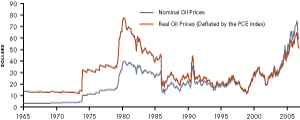Asian Nations Driving World Oil Prices
Oil might not make the world go round, but it surely greases the wheels of economic activity. As the figure illustrates, oil prices have climbed sharply since 2002 to inflation-adjusted levels that approach those reached during the 1979 oil shock. Supply cuts from Middle Eastern exporters generated the very high prices of the 1970s; this time, demand from Asia’s two most populous countries—China and India—is driving price trends.
Market Conditions
Oil is a global commodity; its price depends not only on what happens here in the United States, but also on global supply and demand. Several adverse supply factors have recently boosted oil prices. Some such factors had transitory influences on current production, such as oil workers’ strikes in Venezuela (2002) and Norway (2004), and the March 2006 spill that forced British Petroleum to shut down its Prudhoe Bay facilities in Alaska. Other factors have had longer-term consequences, such as political unrest in Nigeria and Iran, and seasonal hurricane damage to U.S. refineries in the Gulf of Mexico.
Expectations of future supply and future prices also affect current oil prices. Analysts attribute nearly $10 of the oil price increase since 2001 to a “geopolitical risk premium” that reflects the possibility of terrorist attacks on oil facilities or wars in the Middle East.1 The potential price hikes in the wake of such attacks give suppliers an incentive to hold bigger inventories, which leads to higher prices today.
World Oil Prices (West Texas Intermediate)

NOTES: The figure illustrates the rise in both the nominal and real (inflation-adjusted) price of oil since 1965. Inflation adjustments use the PCE deflator level from the year 2000 as the base. Oil price data are from the Wall Street Journal.
But the recent increase in world energy consumption has had perhaps the greatest impact on current oil prices. Higher consumption has translated directly into price increases because spare productive capacity is much more limited today than it has been over the past 20 years.2 This deficiency is partly due to inadequate investment in many countries and partly due to the inexorable global growth in demand for oil in the recovery from the most recent recession.3
Output Growth and Oil Consumption
Worldwide oil consumption increased by a cumulative 11.4 percent from 2001 to 2006 (2.3 percent per annum).4 The United States is the world’s largest petroleum consumer, at 20.6 million barrels per day (mbd). But while U.S. oil consumption has increased by 1 percent annually over the past five years, consumption in other nations, particularly China and India, has grown much faster due to their rapid output growth.5 Over the past 25 years, China’s annual GDP growth—about 9.5 percent—has averaged more than three times that of the United States, while India’s has averaged almost 6 percent, nearly double that of the United States.
Chinese Growth
China’s market-oriented reforms of its economy, called “Socialism with Chinese Characteristics,” began in 1979. These reforms have generated a truly remarkable period of economic progress. For example, average household incomes have increased by nearly 250 percent since 1994.6 The percentage of Chinese households with amenities such as televisions, automobiles and cell phones has more than doubled over this same period, with even greater increases in urban areas.
This economic growth spurred a rising demand for oil, which transformed China from an oil exporter to a major importer. While China was a net petroleum exporter as recently as 1992, its imports reached 33 percent of consumption in 2002. In 2005, China imported about 40 percent of its more-than-seven mbd oil needs, and, in the first five months of 2006, imports were up 18 percent over the same period in the previous year.7
But economic growth alone does not explain China’s rising demand for oil. For example, the Chinese government continues to subsidize consumer energy costs, inviting inefficiency and overuse, particularly in the transportation and agricultural sectors.8 To alleviate pollution, Beijing has begun replacing the country’s coal-fired electricity-generating plants with oil-burning plants. And the Chinese government is now accumulating petroleum reserves to satisfy the International Energy Agency’s (IEA) recommendation of maintaining three months of oil imports.9 These projects have substantially contributed to the country’s overall demand for petroleum.
Indian Growth
Economic reform also has triggered rapid output growth in India. In the 1980s, the Indian government instituted reforms that removed restrictions on capacity expansion, eliminated price controls and lowered corporate tax rates. During the 1990s, the government reduced public monopolies and liberalized international trade and investment regulations.
These reforms have been very successful. The World Bank reports that today India trails only China as the world’s fastest-growing large economy and is the world’s fourth-largest economy on a purchasing-power adjusted basis. This growth has fueled a commensurate demand for oil.
India’s oil consumption increased by 11.9 percent from 2001 to 2006, and it now stands at 2.6 mbd, or 3 percent of global oil consumption.10 India is the sixth-largest crude consumer and the ninth-largest oil importer, relying on other countries for more than 70 percent of its oil. The IEA predicted in 2004 that Indian oil demand would increase by 2.9 percent per year, reaching 5.6 mbd in 2030. This consumption would make India the world’s third-largest oil consumer at current consumption levels.
Growth’s Effect on Oil Prices
Since 2001, the United States, China and India have increased their demand for oil by 0.97, 2.29 and 0.27 mbd, respectively. Global oil production is about 85.1 million bpd. From Jan. 25, 2002, to Jan. 25, 2007, the price of a barrel of West Texas Intermediate Crude, a common benchmark, rose from approximately $19.73 to $53.59.
This thirst for oil surely contributed to the price increase. What would the price of oil have been if consumption growth in those countries had been half of what it actually was over the past five years? A back-of-the-envelope supply/demand calculation can estimate the effect of this growth on oil prices.11 If Chinese oil consumption growth had been only half of what it actually was—1.15 mbd rather than twice that amount—then the price of a barrel of oil would have been $5.57 lower; if Indian consumption had been only half of what it actually was, the price would have been 68 cents lower. By comparison, if the demand from the world’s largest oil consumer, the United States, had risen by only half of what it did— by 0.49 million bpd, rather than by 0.97—the price of a barrel of oil would have been $2.37 lower, or about $51.22.
If all three countries had cut their consumption in half, world demand would have been 1.78 mbd less and prices would be about $8.62 lower, or $44.97. Thus, if demand from China, India and the United States had risen by only half of what it actually did, the price of oil in January 2007 would have been about $45, instead of $53.59. This $8.62 increase was about 25 percent of the total five-year rise in global oil prices. Of course, all of these calculations are just rough estimates.
Conclusion
Oil prices have increased substantially over the past five years. While supply factors have had some impact, increased demand, especially from China, also has played a major role. Simple supply-demand calculations indicate that oil prices would be about 16.1 percent lower if demand growth in the United States, China and India had been half of what it actually was since 2001.
The IEA predicted last year that global energy demand would increase by 53 percent between 2006 and 2030. More than 70 percent of this increase is expected to come from the developing world, particularly from China and India. It seems likely, then, that the growth of these Asian economies will continue to significantly influence oil prices for many years.
Endnotes
- Schwartz (2006). [back to text]
- Greenspan (2006). [back to text]
- The International Energy Agency (IEA, 2006) estimates that world energy consumption will require over $20 trillion in investment in the energy sector by 2030 to satisfy future demand. Roughly half of the investment needed is in Middle Eastern countries. For example, it is believed that Saudi Arabia is currently operating at 99 percent of its productive capacity. Jaffee (2005) discusses investment in the oil industry. [back to text]
- Aggregate oil consumption numbers reported in this article are from British Petroleum (2006) and the Energy Information Administration (EIA, 2007). [back to text]
- IEA, 2004, pp. 82-83. [back to text]
- Gallup (2005). [back to text]
- This calculation uses net imports to China and Hong Kong over total oil consumption. [back to text]
- Andrews-Speed (2006) explains China’s current domestic and international oil policy and the nature of its economic reforms. [back to text]
- Neely (2007) discusses China’s strategic petroleum reserves. [back to text]
- Indian oil consumption for 2006 was estimated by using IEA figures (IEA, 2004, p. 82). [back to text]
- We provide the full details of the supply-demand calculation online. [back to text]
References
Andrews-Speed, Philip. “China’s Energy and Environmental Policies and Their Implications for OPEC.” The CEPMLP Internet Journal, July 2006, Vol. 17, pp. 1-17.
British Petroleum. “Statistical Review of World Energy 2006.” British Petroleum, 2006.
Energy Information Administration. “Short-Term Energy Outlook.” U.S. Department of Energy, February 2007.
The Gallup Organization. “Household Income Doubles in China.” As reported by the Chinese Embassy, January 2005. See www.china-embassy.org/eng/gyzg/t179428.htm.
Greenspan, Alan. Testimony before the Committee on Foreign Relations, U.S. Senate. June 7, 2006.
International Energy Agency. “World Energy Outlook 2004.” OECD, 2004.
International Energy Agency. “World Energy Outlook 2006.” OECD, 2006.
Jaffe, Amy Myers. “The Outlook for Future Oil Supply from the Middle East and Price Implications.” Presented at the Japan/U.S. Joint Seminar on Recent Developments in the Middle East and Future Oil Supply, Tokyo, Japan, July 20, 2005.
Neely, Christopher J. “China’s Strategic Petroleum Reserve: A Drop in the Bucket,” Federal Reserve Bank of St. Louis National Economic Trends, January 2007.
Schwartz, Nelson D. “Why Gas Prices Dropped.” Fortune, Vol. 154, No. 9, Oct. 30, 2006, pp. 27-28.
World Bank. “India Country Overview 2006.” World Bank, 2006.
Views expressed in Regional Economist are not necessarily those of the St. Louis Fed or Federal Reserve System.
For the latest insights from our economists and other St. Louis Fed experts, visit On the Economy and subscribe.
Email Us


